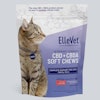
With humanization now essentially a given in the pet space, it makes sense that human food trends (which historically have always had eventual influence on the pet food industry) are now, more directly than ever, driving product development in the pet space.
“Ninety-five percent of pets are considered family,” said James Restivo, client director, pet lead for The Nielsen Company. Restivo, who opened the Petfood Innovation Workshop at Petfood Forum 2018 with his discussion, “The leaders and the followers — How health and wellness trends are shaping pet innovation,” said that pet wellness is of the utmost importance to pet owners. “Even in the indulgent side of pet, the treat side, we’re seeing health and wellness at the underpinning,” he said. “Grain-free treats, meat-first treats, all those trends that are pushing through pet.
Natural pet food continuing to evolve
Natural pet food continues to be a significantly growing market category, consistently producing double-digit annual growth rates in the US market, according to Packaged Facts data. But that growth is not as simple as having a “natural” claim on the bag; rather, pet owners are becoming more nuanced in their search for the perfect diet for their beloved furry family member.
"Humanization trends are driving the natural category in new directions, and leading us across a landscape that reflects people’s contemporary eating habits and their beliefs that their pets’ eating habits should mirror their own,” said Eric Huston, marketing director for Mars Petcare US. “As humans, we think about what we eat; how we like our food prepared; how we like our food to look, smell and taste; its nutritional value; its environmental footprint; and origin and how it was prepared — and then we filter that down to our pets.”
According to Nielsen, “natural” claims in the human space have risen across categories and across departments over the last few years. Not surprisingly, the two biggest departments for natural are baby care and personal care.
“These are things we’re putting on our body and giving to our small children,” said Restivo. Looking at market growth, pet is moving in lockstep with baby care. Pet has had one of the largest growths in terms of share of the category of natural.”
Nielsen isn’t the only one seeing parallels between the pet segment and the baby segment. “We see similarities between the two spaces,” said Corby Reese, managing director of Swander Pace Capital. “Pets are being treated like members of the family. People will spend more and insist on higher quality for their babies and pets than they will for themselves. The pet space today has well-capitalized disruptors both large and small that will push the envelope on emerging trends just like on the human side.”
Understanding the complexity of today’s continued drive for natural pet food is key to being able to stand out as “natural” takes over pet store shelves.
“As the ‘natural’ pet food category has grown more cluttered, we’ve recognized the need to evolve our own philosophy within it,” said Huston. “Consumers seek greater transparency when looking at labels and want wholesome, simple recipes made with real and recognizable ingredients that each serve a distinct and healthy purpose — for both themselves and their pets. Specifically, the rise of non-GMO products speaks volumes to the relevance of this trend.”
Keeping up with the human-pet food connection
It can be a complicated balance, gaining inspiration from the human food space while ensuring formulations that are nutritionally complete for dogs and cats, but it is necessary.
“Pet food trends used to follow human trends by three to five years,” said Reese. “Now that cycle has compressed due to several factors such as a more demanding consumer with more access to information, increased capital investment, and more robust marketing sophistication. In some cases, like digestive health, such as prebiotic and probiotic supplementation, the pet industry has actually led the human industry. Grain-free or gluten-free pet food caught on even faster than for human food.
With things moving so quickly, being able to stay on top of trends and critically analyze data from influencing industries such as human food will be vital to success.
“This is a very competitive industry right now, and you really need to use data science and analytics to make decisions,” said Restivo. “It’s no longer about going with your gut.”
And it’s not just the specialty pet food segment seeing an influx of innovation on the heels of whatever the latest and greatest human food trend is.
“To keep up with growth, we’re going to continue to see trends hit the market at an accelerated rate,” said Huston. “Trends are hitting mass retailers at a much faster pace. One example is the grain-free trend. In January 2011, 0.1 percent of dry dog food sold in merchants like Walmart was grain free. In 2017, it was 20 percent. With ecommerce changing the way consumers shop, we’ll continue to see this rapid movement of humanization trends translated to the pet space in new and surprising ways.
All of this means that it is essential to take advantage of every avenue when it comes to gathering information on human food trends and their possible extrapolation into the pet food arena.
“Pet food companies have a unique opportunity today to speak more directly to the consumer now that more pet food is being researched and bought online,” said Reese. “The best manufacturers will understand this and take advantage and of today's tools to identify emerging trends and create better and more genuine relationships with pet parents.”
In brief: Other human food trends affecting the pet food market
Natural, of course, isn’t the only trend to break into pet food from the human food side. Here are some others mentioned by pet food industry experts that are currently driving pet food formulation:
- Artificial ingredients (lack of)
- Foodie culture: Culinary-inspired recipes that are visually appealing, more authentic smelling and even shaped more in keeping with what human food looks like.
- “Free from” items: GMO, corn, hormones, fillers, artificial preservatives, artificial colors
- Functional ingredients
- “Next-gen” kibble: freeze-dried, dehydrated, raw
- Paleo: ancestral feeding
- Sustainably sourced protein
Pet food and human food: the perfect business marriage?


















